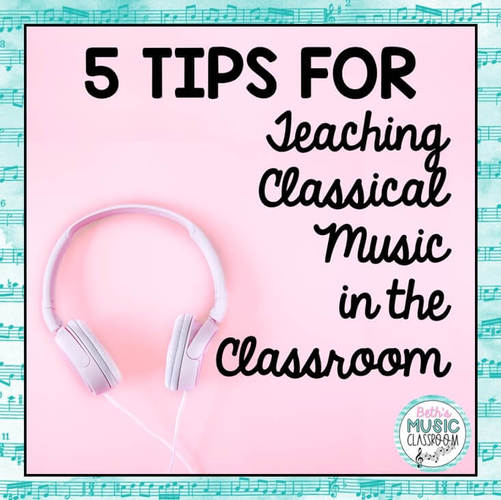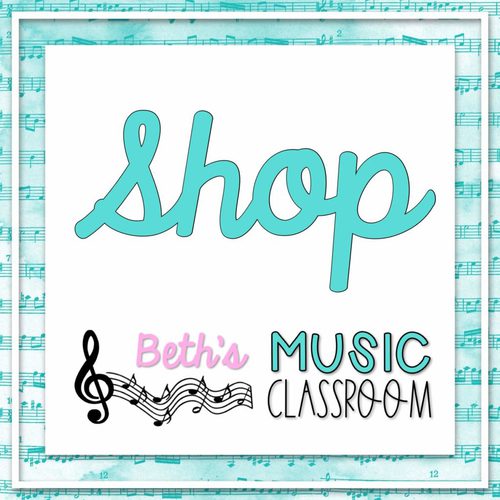
Are you looking to add classical music activities to your elementary music plans? Check out these 5 tips for teaching composers and classical music in the classroom.
Teaching Classical Music to Children
Teaching classical music in the classroom, especially to young kids, can be a daunting task for sure! At my school, we have a three year rotation of composers, with a different one each month. As a Kindergarten through 3rdgrade building, this ensures that students will learn about each of the composers while at the school. When it comes to planning lessons on composers for children, I am always trying to explore new ways to teach them. I don’t merely want to give my students facts about the composer’s life, birthplace, family, music, etc. – not that those aren’t important. They do have their place, but I want my young students to appreciate the music of each composer and to have a deeper appreciation for that music because their life, family, etc.

Music Quote by Arthur O’Shaughnessy
Music Matters – David Elliott
David Elliott, in his book Music Matters, uses the word “musicing” to refer to musical doing. He uses this word in the “collective sense to mean all five forms of music making: performing, improvising, composing, arranging, and conducting.” He also calls the people making the music the “musicers.” If we spend too much time talking about music (i.e. facts, dates, definitions), then I believe that our students will miss out on the enjoyment of “musicing” and being a “musicer.” When performing and active listening to music is effectively used in the lesson, the music, “musicing”, and “musicer” are woven together into a wonderful musical experience.
*If interested in reading Music Matters, you can find it on Amazon here (full disclosure – this is an affiliate link, but you may the same price).
5 Tips for Making Classical Music Fun for Children
So when planning your next lesson on composers for children , here are a few activities that I use to encourage creative thinking, active listening, and active “musicing” in my young students.

Listen to Music!
1. Listening Maps
Anytime you can use (or create) a listening map for students, they help in so many ways. First, they keep students on task and all at the same place in the music. They provide the visual for students in your classroom with something to focus on while the music is heard. Also some listening maps may show the form, themes, instruments, and dynamics used in the piece. This is a great way to encourage young kids to analyze the piece, noticing similarities and differences. Other maps may show a story-like picture relevant to the piece. I have used some animated listening maps for The Nutcracker, and my students absolutely loved them!
2. Using Graphical Scores
If you’re not familiar with graphical scores, they are basically just videos that show the sound in different colored and sized bars that match the music. I came across a few by searching with the added tag of “listening” or “graphical score.” My students just love these. It gives them another one of their five senses to use – not only their ears. I love how the colors even show the different instrument families heard. It can provide a great discussion with elementary students, connecting what they hear with what they see.
Here is one of my favorite graphical scores for you to check out:
3. Listening Glyphs
Listening glyphs are another great way to encourage meaningful listening to all types of music. Basically, students listen to a piece of music, identify key attributes of the music, and color according to the directions. I used these with my 3rdgraders studying The Nutcracker in December. It was a great review of dynamics, tempo, instruments, and form, and the kids enjoyed doing it! If you’re interested in these, a quick search of ‘listening glyphs’ on Teachers Pay Teachers will probably provide you with many choices.
I love these Nutcracker Listening Glyphs from The Bulletin Board Lady – Tracy King.
4. Adding Instruments
Students love playing instruments, and I always try to provide them some time to play along with the composer’s pieces. Depending on the piece, I will either plan to add certain instruments to match the form or to possibly match the instruments in the recording. This obviously needs to be planned out ahead of time, however, there’s always those times where you have a brilliant idea on the spot! My preference is to match the form with different instruments.
Here is one example that I recently used with Mozart’s Rondo alla Turca. On the A section, I had tambourines play their rhythm, displayed on the board. The B section belonged to the triangles, and in the C section, all played (tambourines, triangles, and rhythm sticks). Then D section was only rhythm sticks. This encourages listening as they must follow the piece and listen for their theme to come in again. In this particular piece, it goes back and forth so many times.
If you are interested in finding some more of this type of activities from my store, you can click here for composer instrumental activities. Here are a few of my favorites:
5. Movement Activities
Movement activities for kids, including to Baroque, Classical, and Romantic music, can come in a lot of forms. Folk dancing, mirroring games, and scarf routines are just a few. You can find lots of great ideas in a search on YouTube, and I also really enjoy making up my own.
Several years ago, I took a class with John Feierabend, and I was so inspired by his movement to classical music. With my students, I call it mirror time – as compared to echo time (do it after me). I love watching the kids’ faces as they watch me. I often pass my teacher’s cap onto a student who would like to be the “mirror leader.” I just tell them to make their hands and feet feel and be the music. It also works well to do in pairs, with partners taking turns being the leader. With this activity, I could tell if the leaders are really listening to the music.
Folk dances work really well with short simple compositions or dances, such as Mozart’s 12 German Dances for Orchestra. Use simple repetitive steps for Kindergarten and 1st grade, and then you can add a more complex step for your older students.
I will normally wait to use these movement activities until after they have listened to the piece a 1-3 times with some of the other above methods, and they already have an aural grasp of it.
Active listening to music is so important in music education and to young children. I hope that you can benefit in some way from these ideas. Feel free to e-mail me if you have any questions or comments. Also I’d love to hear about how you encourage active listening in your music classroom. Thanks for reading!




Thanks for your suggestions, Beth! Very useful! I always check your page when I am looking for ideas!
Thanks so much, Janet! That’s so sweet of you. Stay tuned for some new blog posts, sales, and giveaways…coming soon!
I’m teaching a homeschool class (6-8 year olds) at our local co-op entitled “Music & Movement”. I found your article very helpful. You addressed quite a number of things I am considering as well as other things. Thank you so much!!
I’m so glad to hear that! Thanks so much for sharing your input and feedback!